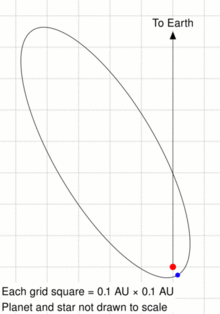Struve 1341
| Observation data Epoch J2000.0 Equinox J2000.0 | |
|---|---|
| Constellation | Ursa Major |
| Struve 1341 A or HD 80607 | |
| Right ascension | 09h 22m 39.7266s |
| Declination | +50° 36′ 13.927″ |
| Apparent magnitude (V) | +9.07 |
| Struve 1341 B or HD 80606 | |
| Right ascension | 09h 22m 37.5679s |
| Declination | +50° 36′ 13.397″ |
| Apparent magnitude (V) | +8.93 |
| Characteristics | |
| Spectral type | G5V / G5V |
| Astrometry | |
| Radial velocity (Rv) | 3.6 / 3.3 km/s |
| Proper motion (μ) | RA: 42.80 / 46.98 mas/yr Dec.: 8.26 / 6.92 mas/yr |
| Parallax (π) | 9.51 / 17.13 mas |
| Distance | 190.41 ly (58.38 pc) |
| Details | |
| HD 80606 | |
| Mass | 0.9 M☉ |
| Temperature | 5370 K |
| Metallicity | 0.43 |
| Age | 7.63 ×109 years |
| Other designations | |
| Database references | |
| SIMBAD | data |
| Database references | |
| SIMBAD | data |
| Extrasolar Planets Encyclopaedia | data |
Struve 1341 is a binary star system approximately 190 light-years away in the constellation of Ursa Major. Both stars orbit each other at an average distance of 1,200 astronomical units. Both stars are more commonly referred to by their Henry Draper Catalogue numbers: Struve 1341 A is called HD 80607, and Struve 1341 B is called HD 80606. An extrasolar planet has been confirmed to orbit HD 80606 in a highly elliptical orbit.
Planetary system

Naef's team in 2001 discovered HD 80606 b.[1][2] It is misaligned with the star's rotation at 53 degrees.[3][4]
At the time, its orbit was the most eccentric orbit of any extrasolar planet known.[5] It has an eccentricity of 0.9336,[6] comparable to that of Comet Halley in the Solar System. The eccentricity may be a result of the Kozai mechanism, which would occur if the planet's orbit is significantly inclined to that of the binary stars. This conclusion is reinforced by the detection of the misalignment, an expected result of the Kozai mechanism.[3]
In a simulation of a 10 million year span, the planet "sweeps clean" most test particles within 1.75 AU of HD 80606. The 8:1 resonance hollows out another Kirkwood gap at 1.9 AU. There cannot be any habitable planets in this system. Also, observation has ruled out planets heavier than 0.7 Jupiter mass with a period of one year or less.[7]
| Companion (in order from star) |
Mass | Semimajor axis (AU) |
Orbital period (days) |
Eccentricity | Inclination | Radius |
|---|---|---|---|---|---|---|
| b | 4.0 ± 0.3[3] MJ | 0.453 ± 0.015[3] | 111.436 ± 0.003[3] | 0.9336 ± 0.0002[6] | — | 0.987 ± 0.061[4] RJ |
See also
References
- ↑ "Exoplanets: The Hunt Continues!" (Press release). Garching, Germany: European Southern Observatory. April 4, 2001. Retrieved December 27, 2012.
- ↑ Naef, D. et al. (2001). "HD 80606 b, a planet on an extremely elongated orbit". Astronomy and Astrophysics Letters 375 (2): L27–L30. arXiv:astro-ph/0106256. Bibcode:2001A&A...375L..27N. doi:10.1051/0004-6361:20010853.
- ↑ 3.0 3.1 3.2 3.3 3.4 Moutou, C. et al. (2009). "Photometric and spectroscopic detection of the primary transit of the 111-day-period planet HD 80606 b". Astronomy and Astrophysics Letters 498 (1): L5–L8. arXiv:0902.4457. Bibcode:2009A&A...498L...5M. doi:10.1051/0004-6361/200911954.
- ↑ 4.0 4.1 Roberts, Jessica E. et al. (2013). "MOST Space Telescope Photometry of the 2010 January Transit of Extrasolar Planet HD80606b". The Astrophysical Journal 762 (21). 55. arXiv:1212.0285. Bibcode:2013ApJ...762...55R. doi:10.1088/0004-637X/762/1/55.
- ↑ Since then, HD 20782 b has been found, at 0.97.
- ↑ 6.0 6.1 Fossey, S. J. et al. (2009). "Detection of a transit by the planetary companion of HD 80606". Monthly Notices of the Royal Astronomical Society: Letters 396 (1): L16–L20. arXiv:0902.4616. Bibcode:2009MNRAS.396L..16F. doi:10.1111/j.1745-3933.2009.00653.x.
- ↑ Wittenmyer, Robert A. et al. (2007). "Dynamical and Observational Constraints on Additional Planets in Highly Eccentric Planetary Systems". The Astronomical Journal 134 (3): 1276–1284. arXiv:0706.1962. Bibcode:2007AJ....134.1276W. doi:10.1086/520880.
External links
- "HD 80606". Extrasolar Visions. Retrieved 2008-06-25.
- "Distant planet's roasting orbit". BBC News. 2009-01-29. Retrieved 2009-01-29.
- Struve 1341 on WikiSky: DSS2, SDSS, GALEX, IRAS, Hydrogen α, X-Ray, Astrophoto, Sky Map, Articles and images
Coordinates: ![]() 09h 22m 37.5679s, +50° 36′ 13.397″
09h 22m 37.5679s, +50° 36′ 13.397″
| ||||||||||||||||||||||||||
